Some woodworkers would revel in the idea of living near and endless supply of beautiful hardwood and then retiring early so as to keep the pesky trials of working-for-a-living a pursuit of the past, leaving only time for working the wood and spoiling the grandchildren. Meet Jim King, a lumberman living in the pith of South America’s Amazon Forest, who very well may be living your dream. Here’s his take on the laborious work to make a tree into workable lumber for us guys and gals who like to use wood for fun.
— Mark Stephens
In order to discuss this topic a number of things must be understood. Possibly the most important and misunderstood fact is that people have been led to believe that there is a huge lumber industry in the Amazon. This is simply not true.
The Amazon, as with any tropical forest, is biologically very diverse and it is not unusual for 100 species of trees to grow on one acre; and no one knows in fact how many species exist.
In the tropical forest there are but a handful of species of any value known and exploited for world markets. Generally speaking, tropical lumbermen are small businessmen of little means. They work in a form that could be best related to as subsistence living.
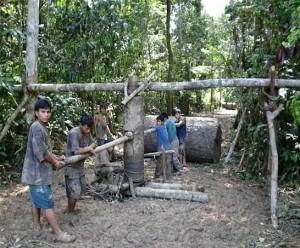
Typical logging operation winching logs out (built on-site). Log is from a Lupuna tree which is cold peeled for plywood manufacture.
The logs can be winched as far as a mile plus over a couple of days using a series of winches if the area has enough trees of a species to justify the cleaning and maintaining of a winch trail that long. Nothing goes to waste, either. The cables used for winching will later be used to lash the logs together for the trip to market.
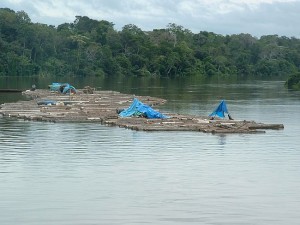
After a year's hard work with the entire family or families, the logs are lashed together and floated downstream to market
This happens normally starting in December when the water rises from the snow melt from the Andes Mountains and rises up to 40 feet to make movement by river possible. Depending on where the harvest was made, the unpowered float trip can take two weeks or more. The young strong ones of the family do the majority of the hard work. The mother, grandmother and kids do the cooking and the older men are in charge of obtaining food.
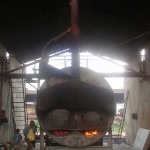
In the early 1900's this boiler served on a European ship. It was salvaged out of the river and is now the heat source for a series of dry kilns. It survived well to live again.
After the wood is sawn and possibly dried it is loaded on barges at a port and sent to mid river where it can be loaded onto an ocean going vessel for shipment to international markets. Very little value added products are made in the Amazon, it is a supplier of raw lumber to developed countries.

Typical housing for loggers. An area of about 50 feet in diameter is cleared around the house to protect it from falling trees, and animals and snakes

A hergon, the most feared thing in the jungle. Very poisonous and they kill many people every year. Not a good way to go.
The people of the Amazon Forest survive on the equivalent of $19 per month, and few of them even know how to read and write. In the mind of these local subsistence farmers, the big hardwood trees on their own property have little value for lumber or other products that could be sustainably extracted from trees – such efforts require mountains of paperwork and costly cutting licenses (which is approximately $1000 for every 100 acres). The people of this region have one primary concern: how to feed, clothe, and shelter their families for $19 a month.
Right or wrong, they slash and burn like they have done for centuries to make space for crop and grazing lands. Now the problem escalates. Cleared rain forest land has no long-term value as crop land. The soils are very poor in nutrients and high in pH due to the heavy rainfall and clay soils making plants not common to the rain forest such as corn and beans virtually impossible to grow. Because it’s all they have, locals must clear new forest areas every couple of years in order to keep growing food. Deforestation continues on.
It stands to reason that the people who live in the Amazon must learn to utilize the forest as a source of products to sell, not just chop it down, in order to exist. The most logical thing is well managed productive forests.
If these people had a market for just a couple of trees per month they could live a middle class lifestyle “for the Amazon” and not destroy the forest. Remember that the current average monthly cash income of a subsistence farmer family is $19. It seems unfair when the people are living in one of the most naturally abundant areas of the world.
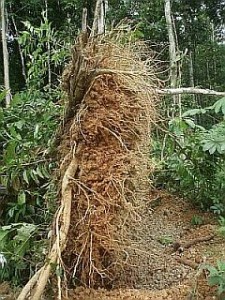 This is typical of a tree that is mature and about to die. When trees reach maturity and reach the top of the canopy they normally just fall over and rot. They have virtually no root system and the slightest breeze will blow them over creating light for the hundreds of seedlings below it to try and gain the spot. One of seedlings will fight and fill this opening.
This is typical of a tree that is mature and about to die. When trees reach maturity and reach the top of the canopy they normally just fall over and rot. They have virtually no root system and the slightest breeze will blow them over creating light for the hundreds of seedlings below it to try and gain the spot. One of seedlings will fight and fill this opening.
The future of the tropical forests depends on proper use and proper management of the forest. The world is in the midst of a population explosion and it is very difficult to train people not to eat. They need productive jobs, not service or office jobs or free sacks of rice. They need to feed their families in a way that is not destructive and that they can be proud of.
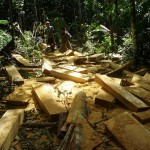
Making billets out of logs on site in the jungle causes less damage to the forest than dragging out whole logs.
The Amazon has a major renewable resource which is wood which if managed properly will feed the people and create a society that is not dependent on international welfare and without harm to the tropical forest.
The forest, as with any other resource, has no value unless it is used and managed. According to the web site of “Friends of the Earth” Brazil produces some 6 billion board feet of lumber in total legally and illegally. This is virtually the same as a typical years’ production for Oregon. The Brazilian Amazon is 1.5 million square miles whereas the entire state of Oregon is 98,000 square miles. The Peruvian Amazon, which also is much bigger than Oregon, produces less than 1% of the annual sustainable production of Oregon.
There is really not much lumber coming out of the vast Amazon.
The world should know that if they would buy tropical lumber products they would be helping save the tropical forests from clear cutting and destruction. Buy tropical lumber and save the tropical forest.
